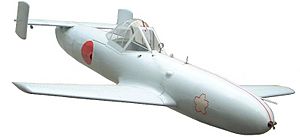Ohka facts for kids
Quick facts for kids MXY-7 Ohka |
|
|---|---|
 |
|
| Ohka Model 11 replica at the Yasukuni Shrine Yūshūkan war museum. | |
| Role | Kamikaze anti-ship aircraft / missile |
| National origin | Japan |
| Manufacturer | Yokosuka Naval Air Technical Arsenal |
| First flight | 21 March 1944 (unpowered), November 1944 (powered). |
| Introduction | 1945 |
| Retired | 1945 |
| Status | Retired |
| Primary user | Imperial Japanese Navy Air Service |
| Produced | 1944–1945 |
| Number built | 852 |
The Yokosuka MXY-7 Ohka was a special rocket-powered aircraft used by Japan at the end of World War II. It was built for "Kamikaze" attacks. This meant the aircraft was flown directly into Allied ships. The name Ohka (櫻花) means "cherry blossom" in Japanese.
Contents
What was the Ohka?
The Ohka was a unique type of aircraft. It was designed to be a human-guided missile. This means a pilot would steer it towards its target. It had a powerful rocket engine. This made it very fast. However, it could not fly very far on its own.
How it worked
The Ohka was a small plane. It was powered by rockets. These rockets gave it a huge burst of speed. This speed made it hard for enemy ships to shoot down. But the rockets only worked for a short time. After the fuel ran out, the Ohka would glide.
Carried by other planes
Because the Ohka had a short range, it could not fly from a faraway base. Instead, it had to be carried into battle. A much larger bomber aircraft would carry the Ohka underneath it. This larger plane would fly close to the enemy ships. Then, the Ohka would be released. This made the bomber aircraft very vulnerable to enemy fighter planes.
Ohka in battle
The Ohka was first used in 1945. This was during the Battle of Okinawa. Ohka attacks managed to sink or damage some smaller ships. These included escort vessels and transport ships. However, they never sank any large warships. Japanese engineers tried to make better versions of the Ohka. They wanted to fix its short range. But these improved models were ready too late to be used in the war.
The "Baka Bomb" name
Allied soldiers and sailors gave the Ohka a nickname. They called it the "Baka Bomb." The word baka is a Japanese word. It means "fool" or "stupid." This nickname showed how the Allies felt about the Ohka's design and use.
Related pages
Images for kids
-
K-1 Ohka Trainer, National Museum of the U.S. Air Force
-
Thermojet powered, Model 22 Ohka. National Air and Space Museum
-
The rear of Ohka, Royal Air Force Museum Cosford
See also
 In Spanish: Yokosuka MXY-7 para niños
In Spanish: Yokosuka MXY-7 para niños









